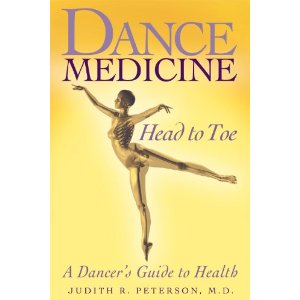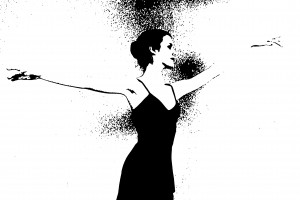
by Jan Dunn MS
Stretching feels sooooo good!
Dancers love to stretch–we do it all the time, whenever we can–before class, during class, after class, watching TV, waiting for the bus (seriously–haven’t you ever done a quick calf stretch while standing there?) –but how many of us really know that much about stretching? -i.e, the Do’s and Don’ts of doing healthy stretching?
Ankle-on-the-barre stretching….one of our favorites, and found in almost every ballet class……but–the problem with this position is that it puts so much weight on the Achilles tendon, on the back of the ankle—and can potentially lead to Things You Do Not Want To Have, like Achilles tendinitis. Far better to stretch your hamstrings (back of the leg) or adductors (inner thigh) — which is what that stretch does — by sitting on the floor, or using Theraband lying down, etc.
Watching cold (as in not-warmed-up) dancers sitting on the floor stretching was the impetus for getting this particular article out to you, especially as you start off 2014!
So here’s what you need to know about stretching (in no particular order of importance):
1- WHEN to stretch: When you are warmed-up.
Think of it this way–if you take a cold rubber band and pull it taut, what might happen (Yikes!)? Yes, it might snap. Your muscles are like that. When we stretch stone cold (as in before a class or rehearsal), that’s what we are doing. We are potentially pulling small muscle fibers that may tear as a result.
LIGHT stretching before a class, which means alternating contracting and releasing a muscle is OK–(the stretch comes when you release), but heavy duty stretching (the on-the-floor or leg-on-the-barre variety) is not advised.
You want your muscles good and warm before you start heavy stretching–as in the middle of class, or at the end.
2- How LONG to stretch: Again, if you’re warmed up–
Usually a minimum of 30 seconds is recommended–that gives the muscle fibers time to really lengthen. If you don’t have a second hand around, timing it to last about 3 nice long breaths is usually about 30 seconds for most people (or take the deep breaths with a second hand in front of you, and see how many you personally might need).
Sometimes in rehab, physical therapists will have you hold a stretch longer than the 30 seconds–but that’s a different situation.
3- If you have some very tight muscles that you want to hopefully permanently lengthen, it’s recommended that you do it at the end of a class / rehearsal / performance (i.e, when you’re really warm). Take the desired stretch and do 3 or 4 sets of the 30 second stretch, with a slight pause (maybe 10 sec.) in-between, doing this as your body cools down.
4- If you have really held a stretch for a long time, for whatever reason, don’t ask the muscle to contract immediately afterwards. They lose that ability briefly when heavily stretched, so you want to be careful.
5- We’ve already talked in this column, about how weather / age, etc. affect your body, but here’s a brief reminder when it comes to stretching:
-the colder the weather / room, the longer it takes to warm-up — i.e, the longer it will take to get to a good stretching place for your body!
-a muscle that has been injured may take longer as well.
-the older we get, the longer it takes / the more careful we have to be — we lose some of our flexibility as part of the natural aging process, so be aware that you can’t stretch as fast / easily at 40 as you can at 20!
6- There are different types of stretching–the two main types that we use are usually:
-Static: where you take the desired stretch and just hold it.
–Ballistic: bouncy stretches —not recommended (they can inadvertently tear small muscle fibers).
There are other types – such as Prolonged, Proprioceptive Neuromuscular Facilitation (PNF), and Dynamic, which I won’t go into in this article. But if you go to the IADMS website, there is an excellent Resource Paper on Stretching, which goes into considerable detail on this topic.
7- A word here about the difference between general flexibility / joint mobility, and Joint Hypermobility Syndrome (JHS), which is a very different thing. It’s a very specific condition which has to be medically diagnosed by a physical therapist or other medical practitioner – it takes the joint beyond what we think of as general overall flexibility. It’s something that both dancers and teachers need to be aware of, as studies have shown that a good number of younger dancers may have it, and if they do, it does impact their dance lives (and their everyday lives). It doesn’t mean you can’t dance if you fall into this category, but it does mean you and your teacher should know about it, and about how to train properly.
We have a special article on the site dedicated to JHS.
8- And last but not least:
Research has shown us that stretching before a class, when cold, actually decreases such things as strength, power, endurance, balance, jump height and other factors that we use in dance movement. So when you are sitting on the floor stretching before class, you’re not only potentially injuring yourself, but also negatively affecting the dance activity you are about to do–whether it’s class / rehearsal / performance.
SOOO……I hope all of the above has been informative and helpful–and even better, maybe just a good reminder, because you already know all of this and are already Stretching Healthy!
Happy Valentine’s Day!

Editor Jan Dunn is a dance medicine specialist currently based on the island of Kauai, Hawaii, where she is owner of Pilates Plus Kauai Wellness Center and co-founder of Kauai Dance Medicine. She is also a Pilates rehabilitation specialist and Franklin Educator. A lifelong dancer / choreographer, she spent many years as university dance faculty, most recently as Adjunct Faculty, University of Colorado Dept. of Theatre and Dance. Her 28 year background in dance medicine includes 23 years with the International Association of Dance Medicine and Science (IADMS) – as Board member / President / Executive Director – founding Denver Dance Medicine Associates, and establishing two university Dance Wellness Programs
Jan served as organizer and Co-Chair, International Dance Medicine Conference, Taiwan 2004, and was founding chair of the National Dance Association’s (USA) Committee on Dance Science and Medicine, 1989-1993. She originated The Dance Medicine/Science Resource Guide; and was co-founder of the Journal of Dance Medicine & Science. She has taught dance medicine, Pilates, and Franklin workshops for medical / dance and academic institutions in the USA / Europe / Middle East / and Asia, authored numerous articles in the field, and presented at many national and international conferences.
Ms. Dunn writes about dance wellness for 4dancers and also brings in voices from the dance wellness/dance medicine field to share their expertise with readers.









